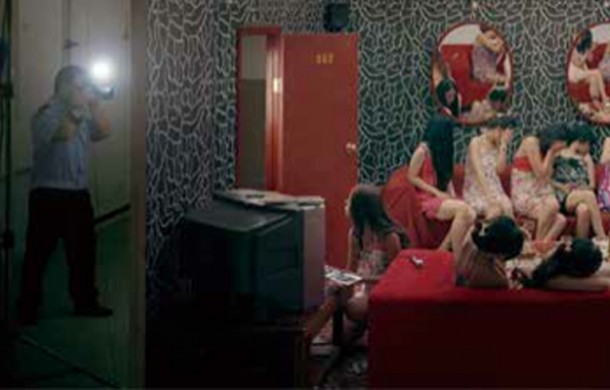CAI DONGDONG: DRAFTSMANSHIP
| May 10, 2013 | Post In LEAP 18

Upon entering Matthias Küper, one can easily be baffled by the show’s half-installed state. A roll of foam-wrap sits in the corner while several photographs rest against the room’s walls, ready to be hung. Cai Dongdong invites the viewer into a fragmented realm, one not yet done but not quite undone; his use of carefully selected, yet arbitrarily placed items challenge notions of false realities. Paralleling his photographs, his experimentation with image composition diminishes clarity between realities, such that the only distinction between the incidental and the intentional is the concrete knowledge of such.
Surrounded by a cluttered room of personal relics and snapshots of Cai Dongdong’s past, a mother quietly breastfeeds her child. First welcoming you into the performance installation, Breast Feeding (2012) primes the viewer to understand Cai’s works at face value: as snapshots. Yet Breast Feeding’s juxtaposition with the other staged photographs questions the voyeur’s ultimate understanding of reality. Is it merely the exclusion of set walls and willfully placed subjects that negates one’s ability to acknowledge the photograph’s origin? Can an intricate set, paired with the logic-seeking mind, dupe the viewer into believing its reality?
Atop a stage in the room’s center sits a large format camera, one so large it could have been used in the days of Daguerre himself. Pointed at a makeshift set filling one side of the gallery, the camera was utilized during an opening performance. With seating for eight, the set incorporates the audience experience by way of three oval mirrors. Seen in the reflection, the onlookers are documented as just that: in relation to the performance. The performance enters a palpable reality as the artist captures this decisive moment within two dimensions, namely through the viewer’s personal experience and memory, and also by the camera, serving as a once-removed, concrete witness to the performance’s viewership. For without this photographic recording, the performance is remembered but fleetingly in the minds of the audience; as the viewers disperse and time passes, its very occurrence comes into question.
In the tradition of war photography, The 8th of Lunar December (2008) depicts members of the Chinese Nationalist Party executing revolutionaries. Inspired by Goya’s The Shootings of May Third 1803, Cai re-appropriates the work to re-explore and reevaluate perceptions of death. Yet Cai Dongdong’s hand selection of this stage’s various components leads to a satirical play on the notion of “shoot”; by replacing an armed soldier with a camera-equipped photographer, the charged revolutionary is shot. To be shot signifies death but also an internment in history. Consequentially, Cai radically alters not only the event’s historical significance, but also its existence in photographic reality.
The psyche’s attempt to avoid reality is inevitable, yet whether out of fear or disinterest, the documented reality will continue. In The Evasion of Light (2010), Cai Dongdong nods at the widespread yet underground “escort” services in China. Captured on camera by a policeman who is himself photographed standing just outside the set, 17 seated women turn and shield their faces. Yet one lone girl curiously stares upwards at her potential prosecutor, sitting on the ground perhaps just outside of the periphery of the policeman’s lens. Only the crime scene negative can conclude whether she was there or not. Whether she was actually documented in the damning evidence remains a mystery to not only those viewing the work, but also likely to the artist himself. Her existence is again captured by a removed observer, regardless of being documented by the viewer within.
Incorporating the complexities of reality, Cai Dongdong’s elaborate sets create altering dimensions in which the significance and occurrence of events is altered. Further, the inclusion of a documenter within these sets pushes the psyche to question the truth of these dimensions, real and otherwise. For in both photographs and daily life, the intentional can only be deemed as such by he who has intended it to be.

